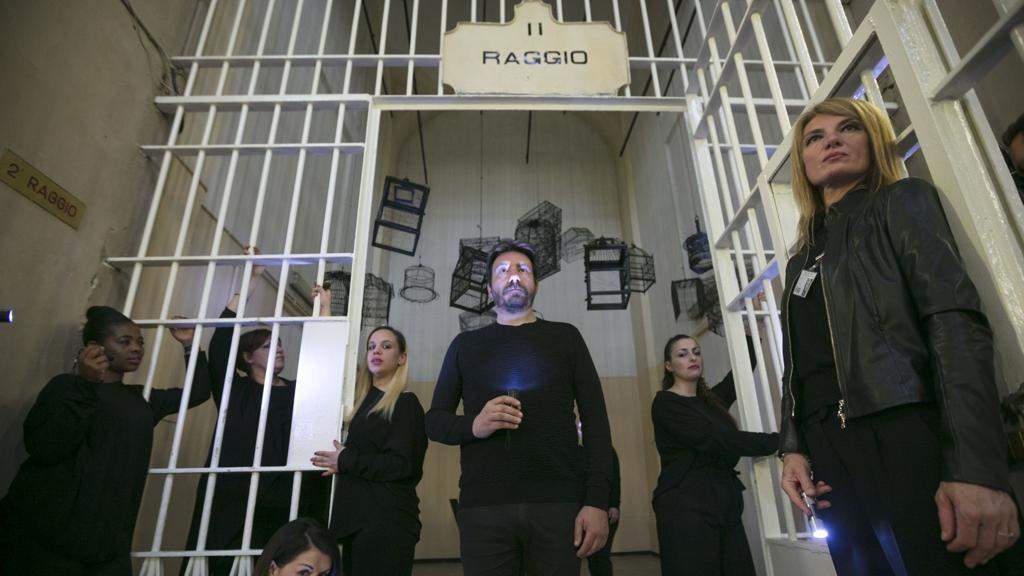The genesis of a performance art in prison. The Diary of Andrea Bianconi
A book to enter the mind, the emotions, the creative process of an artist: it is called Diary of a pre-prisoner and is the artist’s book by Andrea Bianconi (Vicenza, 1974) published by Silvana Editoriale (176 pages, 28 euros, ISBN 9788836645534): a sum of reflections, scattered thoughts, streams of consciousness, illustrations, technical details, and lists of daily activities that the artist made in the two weeks before enacting the performance Prisoner of love at the San Vittore prison in Milan last April 3, in collaboration with Casa Testori. It was a theatrical-musical performance, during which the inmates of the women’s section of the prison sang, together with the artist, a song on the theme of the search for love and its importance in our lives, all preceded by the reading of a page by Giovanni Testori.
Between the pages of the diary, entirely handwritten and devoid of page numbers but marked only by dates (also handwritten by Andrea Bianconi) chase each other the artist’s thoughts and ideas, the moments of his days (even individual phone calls, on certain days!), the number of hours he spent sleeping (which tended to be few), some memories (such as when, on March 25, nine days from the date of the performance, Bianconi relives “brief schematic memories” for almost all the years of his life), the day-to-day encounters, the lineup of the action, its modifications, the apparatuses to accompany it, the visits to the blacksmith’s for making the cages (one of the symbols of Bianconi’s poetics: “the open cage,” he writes in the Diary, “is a flower that is blooming and the walls look like wings”) to be carried in the rays of the San Vittore prison, as a symbol of freedom according to the détournements also typical of Bianconi’s way of making art (the gambia, a symbol of oppression and imprisonment, is opened and emptied of all its negative elements).
 |
| The cover of the book |
 |
| Andrea Bianconi in the preparations for the performance at San Vittore |
What Bianconi brought to the stage at San Vittore, as critic Giuseppe Frangi explains in the afterword to Diario di un pre-carcerato, is precisely anexperience of freedom: “it is a space of action,” Frangi writes, “that does not obey a logic, much less a rule. A space in which the artist is not called to a reckoning with a why. Freedom then is guaranteed by the fact that the performance is once and for all, once it has happened it dematerializes and lives only in the documentation of what has happened.” After all, it is Bianconi himself who defines, in just five words, repeated throughout a page on March 29, the meaning of his performance in San Vittore: “I will enter and bring freedom.”
Not an easy gestation for a work that is certainly courageous (for the choice of dealing with an uncomfortable and very complex theme such as that of prison, of imprisonment), dense with meaning, sincere, strongly desired by an artist who entrusts to his pen and drawings all his emotional flow mindful of Joyce’s Finnegans Wake (an author to whom Bianconi is very close), which is therefore shared with the reader: an operation that allows (something that not all artists allow) one to enter into the intimacy of an artist in order to understand the reasons for his artistic making (also because, in the pages of the diary, Andrea Bianconi also returns to some of the symbols that characterize his art and have made him famous). There is also no shortage of references to Fantastic Planet, Bianconi’s solo show held shortly before the performance at CAMeC in La Spezia(Federico Giannini’s review here).
“In all my performances,” the artist wrote on March 28, “the other is fundamental and determinant; the other understood as a person, the other I, culture, people, ... in this case the other is the other human condition. It is the deprivation of freedom. The other is what we do not know. I do not imagine myself to be unfree. Here knowledge intervenes, the moment I know the other I can seek or find my freedom. The arrow (and the direction) can help. I think the other is the engine of my life. I make no distinction between art, performance and life.” Here, then, from the pages of Diary of a Pre-Prisoner emerge the meaning of Andrea Bianconi’s art, the energy that drives his imaginative imagination, in all the purity of his thought.
A book, then, to get to know the artist, enter his creative process, understand even the harshness of prison reality (there is no lack of reflections by the Venetian artist precisely on the theme of prison), understand what is the very high value of the re-educative function of punishment (guaranteed by Article 27 of the Constitution), and experience the genesis of a work capable of expressing Andrea Bianconi’s artistic awareness and human consciousness.
 |
| The genesis of a performance art in prison. The Diary of Andrea Bianconi |
Warning: the translation into English of the original Italian article was created using automatic tools. We undertake to review all articles, but we do not guarantee the total absence of inaccuracies in the translation due to the program. You can find the original by clicking on the ITA button. If you find any mistake,please contact us.





























